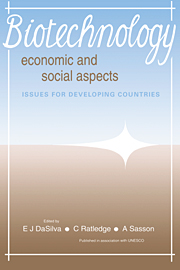Book contents
- Frontmatter
- Contents
- List of contributors
- Preface
- 1 Biotechnology: the socio-economic revolution? A synoptic view of the world status of biotechnology
- 2 Bioethanol production: economic and social considerations in failures and successes
- 3 Biofertilizers: agronomic and environmental impacts and economics
- 4 Microalgal biotechnology: is it an economic success?
- 5 Production of useful biochemicals by higher-plant cell cultures: biotechnological and economic aspects
- 6 Mushroom production – an economic measure in maintenance of food security
- 7 The economic viability of Single Cell Protein (SCP) production in the twenty-first century
- 8 The impact of biotechnology on international commodity trade
- 9 Biotechnology: socio-economic considerations, intercultural perspectives and international viewpoints
- 10 Joint microbial biotechnological ventures in developing countries: social promises and economic considerations
- 11 The economic and social implications of gene technology to developing countries
- 12 Making biotechnology appropriate – and environmentally sound
- 13 Information support for research and development in biotechnological applications
- 14 The effects of emerging biotechnologies on plant and animal agriculture – a viewpoint
- Index
3 - Biofertilizers: agronomic and environmental impacts and economics
Published online by Cambridge University Press: 04 August 2010
- Frontmatter
- Contents
- List of contributors
- Preface
- 1 Biotechnology: the socio-economic revolution? A synoptic view of the world status of biotechnology
- 2 Bioethanol production: economic and social considerations in failures and successes
- 3 Biofertilizers: agronomic and environmental impacts and economics
- 4 Microalgal biotechnology: is it an economic success?
- 5 Production of useful biochemicals by higher-plant cell cultures: biotechnological and economic aspects
- 6 Mushroom production – an economic measure in maintenance of food security
- 7 The economic viability of Single Cell Protein (SCP) production in the twenty-first century
- 8 The impact of biotechnology on international commodity trade
- 9 Biotechnology: socio-economic considerations, intercultural perspectives and international viewpoints
- 10 Joint microbial biotechnological ventures in developing countries: social promises and economic considerations
- 11 The economic and social implications of gene technology to developing countries
- 12 Making biotechnology appropriate – and environmentally sound
- 13 Information support for research and development in biotechnological applications
- 14 The effects of emerging biotechnologies on plant and animal agriculture – a viewpoint
- Index
Summary
Introduction
During the last decades increased fertilizer and pesticide use contributed to a spectacular increase in crop production, especially in Asia and South America. However, the price of fossil-fuel-based inorganic fertilizers relative to the prices of most stable crops has increased and chemical pesticides are both costly and harmful when they persist in the soil and enter the food chain. This explains the emphasis on current attempts to control soil- and plant-associated microorganisms, to lower fertilizer production costs, reduce environmental pollution whilst ensuring fair or even high yields, and to expand the adaptability of plants to reputedly unfavourable situations. The approach adopted is to introduce into soil or rhizosphere soil symbiotic or non-symbiotic microorganisms, a practice known as inoculation. The inoculants are also known as biofertilizers. Inoculation of plants by beneficial bacteria or fungi is routinely used in the legume-rhizobia symbiosis, fairly often in the ectomycorrhizal and to some extent in the endomycorrhizal symbiosis. Recently inoculation of actinorhizal plants has been developed and successfully adopted both in temperate and tropical countries. With some exceptions, inoculation with plant-growth-promoting rhizobacteria (PGPR) is still in its experimental stage. Soil inoculation with free-living blue-green algae has been and is still practised in Southeast Asia but the results are irregular.
In this chapter the discussion is restricted (1) to the presentation of the main types of biofertilizers (exclusive of Azolla and other green manures) and their modes of action, (2) to their agronomic and environmental benefits, (3) to biofertilizer technology, and (4) to the economics of the application of biofertilizers. The use of chemicals of microbial origin such as antibiotics or toxins (e.g. toxins produced by Bacillus thuringiensis) is not dealt with.
- Type
- Chapter
- Information
- Biotechnology: Economic and Social AspectsIssues for Developing Countries, pp. 55 - 69Publisher: Cambridge University PressPrint publication year: 1992
- 5
- Cited by

